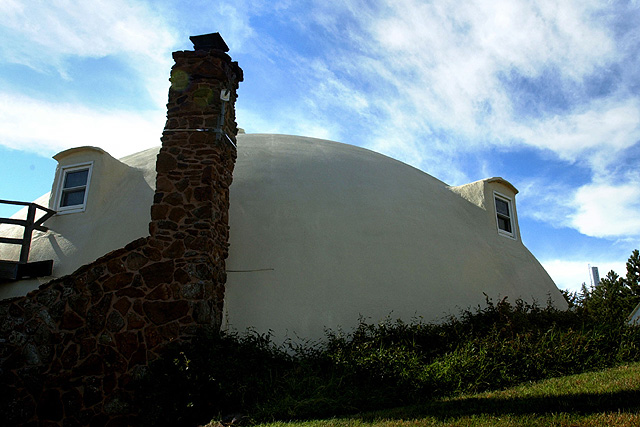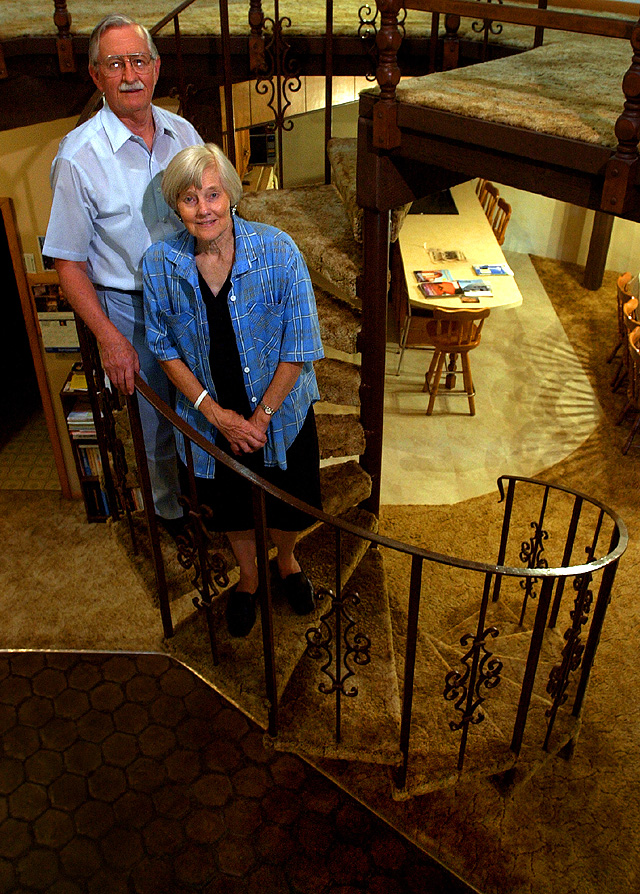Couple happy with dome on the range
Lower energy costs among benefits of unusual home, owners say
Salina ? Norbert and Marlene Hermes have lived in a concrete dome for the last 23 years and have never regretted it.
The dome not only has saved them money in energy costs, but it is so solidly built that tornadoes, fires, floods, earthquakes, hurricanes and probably even plagues of Biblical locusts would have a hard time penetrating it.
The one-piece rounded, steel-reinforced block of concrete that forms the hull of their home is called a monolithic dome. When the Hermeses built one in 1980 on a hillside on their rural Salina property, nearly everyone they knew thought it was a wild idea.
“There are some that probably still think we’re crazy,” said Norbert, a retired Salina school counselor and psychologist. “But it’s given us great energy efficiency over the years, and it’s a solid shelter against natural disasters. Air currents move around and over the dome, and there are no flat surfaces for a tornado to bump against. It doesn’t rattle or settle like other houses. We’ve been very happy with it.”

The monolithic dome house owned by Norbert and Marlene Hermes, of Salina, is nestled in the hillside of their property. For the first 10 years they lived in the structure, the Hermes relied soley on the heat of their stone fireplace to ward off the winter cold.
The Hermeses recently opened their dome home to the public as part of a nationwide monolithic dome tour co-sponsored by the Monolithic Dome Institute and the Monolithic Dome Builders Assn.
“We’re glad to let people come and see the home’s endurance – and ours, too,” Marlene said.
When the couple built their monolithic dome, it was only the fourth such structure in Kansas. Since then, several others have been built, including Salina’s Church of Christ and the Sternberg Museum of Natural History in Hays. Domes also have been utilized for schools, offices and bulk storage facilities in 45 states and several foreign countries.
The Hermeses still have the only private dome home in the Salina area.
“We’re still the pioneers, I guess,” Norbert said. “For some people, it still looks like a big igloo, but it’s beginning to catch on more.”
For the first 10 years they lived in their monolithic dome house, the Hermeses relied on firewood for heat during the winter months.

Norbert and Marlene Hermes, of Salina, stand on the spiral staircase of their monolithic dome house.
Norbert cited the fuel and energy crisis of the late 1970s for causing many Americans to explore alternative ways to conserve energy. At one point, Norbert had contemplated building an underground earth shelter, but when he was told about a monolithic dome being built in Hill City, he decided to investigate it and liked what he saw.
The dome construction began with a concrete ring foundation that was reinforced with vertical steel bars. An airform, or nylon “balloon,” was placed on the concrete base and inflated using blower fans. The airform not only creates the shape of the structure to be completed but becomes the outer roof membrane of the shell when finished.
About 3 inches of polyurethane foam was applied to the interior surface of the airform, and then steel reinforcing bars, or rebars, were attached using special hooks embedded in the foam. A spray mix of concrete was applied to the interior surface of the dome – about 8 inches thick at the base, tapering to 4 inches at the top.
The finished shell for the home measured 55 feet across by 26 1/2 feet high, encasing a 4,300-square-foot living space.
“After the exterior was built, the rest was interior work, most of which I did myself,” Norbert said. “We were able to move in within a year.”
The 1980 cost for building the dome was about $21 per square foot. Today’s cost is about $75 per square foot, according to the Monolithic Dome Institute. Norbert said it still is a substantial savings compared to building costs of many conventional homes.
“With the price of concrete, the initial cost may be more now, but you can recoup that in no time with the energy savings,” he said.
The Hermeses primarily use propane fuel and a fireplace to keep the interior heated in winter and ceiling fans to circulate air during summer months. Although they have installed an air-conditioning system, Marlene said, they hardly ever use it.

